Labour Force Survey, June 2024
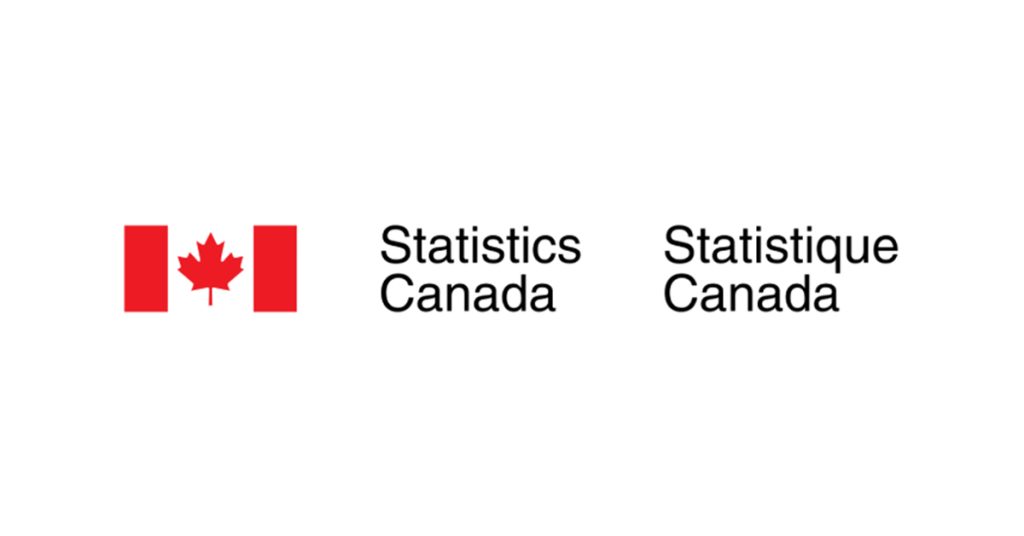
July 12, 2024
Labour Force Survey Highlights
Employment was virtually unchanged in June (-1,400; -0.0%), and the employment rate fell 0.2 percentage points to 61.1%.
The unemployment rate increased 0.2 percentage points to 6.4% in June and has risen 1.3 percentage points since April 2023.
In June, employment fell among young men aged 15 to 24 (-13,000; -0.9%), while it increased for core-aged women (aged 25 to 54) (+19,000; +0.3%).
There were declines in the number of people working in transportation and warehousing (-12,000; -1.1%) as well as in public administration (-8,800; -0.7%) in June. At the same time, there were more people employed in accommodation and food services (+17,000; +1.5%) and in agriculture (+12,000; +5.5%).
Employment declined in Quebec (-18,000; -0.4%) in June, while it increased in New Brunswick (+3,000; +0.8%) and Newfoundland and Labrador (+2,600; +1.1%).
Total hours worked were down 0.4% in June. On a year-over-year basis, total hours worked were up 1.1%.
Average hourly wages among employees increased 5.4% in June on a year-over-year basis, following growth of 5.1% in May (not seasonally adjusted).
The employment rate for returning students aged 15 to 24 was 46.8% in June, down from 51.7% a year earlier (not seasonally adjusted).
Employment virtually unchanged in June
Employment was virtually unchanged (-1,400; -0.0%) in June, following little change in May (+27,000; +0.1%).
The employment rate—the proportion of the population aged 15 and older who are employed—declined by 0.2 percentage points to 61.1% in June, the eighth decrease in the past nine months. The employment rate has declined by 1.3 percentage points from the recent high of 62.4% observed in January and February of 2023.
On a year-over-year basis, employment was up by 1.7% (+343,000) in June 2024. Employment growth in the 12 months to June was faster in the public sector (+4.3%; +183,000) than in the private sector (+0.8%; +106,000). Self-employment in June was up on a year-over-year basis (+2.1%; +55,000), but remained lower than its average from 2017 to 2019 (-4.3%; -121,000), prior to the COVID-19 pandemic.
Chart 1
Employment rate falls in June, continuing downward trend
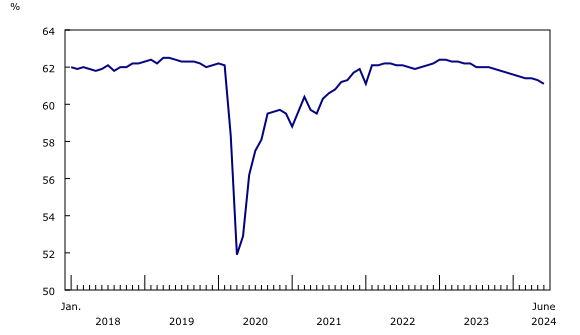
Employment rate declines for youth and core-aged men
Employment fell among young men aged 15 to 24 in June (-13,000; -0.9%), while it held steady for young women. The overall youth employment rate has been on a strong downward trend since April 2023, falling 4.4 percentage points to 54.8% in June 2024.
For men aged 25 to 54, employment was little changed (-14,000; -0.2%) in June, and the employment rate fell 0.5 percentage points to 86.6%. This extended a downward trend in the employment rate from a recent high of 88.2% in June 2023. The rate in June 2024 was comparable to the pre-pandemic average of 86.5% observed from 2017 to 2019.
For women aged 25 to 54, employment rose in June 2024 (+19,000; +0.3%) and the employment rate held steady at 80.6%. The employment rate of core-aged women has trended down from the record high of 82.0% in January and March of 2023, but remained above the pre-pandemic average observed from 2017 to 2019 (79.3%).
Employment for people aged 55 to 64 was little changed in June 2024. On a year-over-year basis, the employment rate for people in this age group was up by 0.9 percentage points to 69.8% for men, and was little changed at 60.4% for women.
Infographic 1
Employment rate continues downward trend for youth and core-aged people
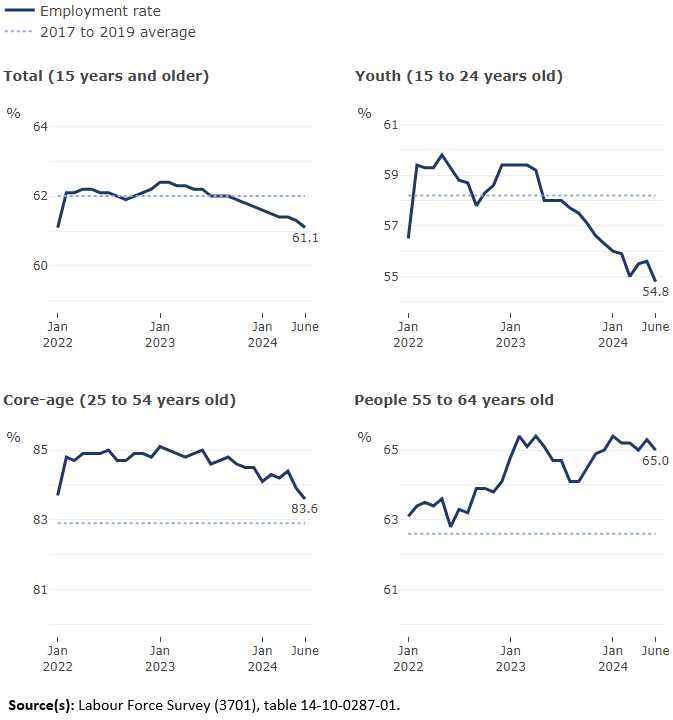
Employment rate of returning students at its lowest point since June 1998
From May to August, the Labour Force Survey collects labour market information from students who attended school full time in March and who intend to return to school full time in the fall.
In June, the employment rate for returning students aged 15 to 24 was 46.8%, the lowest rate since June 1998, outside of June 2020 during the first year of the pandemic (not seasonally adjusted). This marks a notable decline from the recent high of 53.7% observed in June 2022.
The unemployment rate among returning students was 15.9% in June 2024, and was up 3.8 percentage points from a year earlier. This indicates that students are facing more difficulties finding work as they enter the summer job market.
In June, the employment rate for male returning students was 44.4%, down 5.5 percentage points from a year earlier. Among female returning students, 49.0% were employed in June, down 4.4 percentage points over the same period.
Returning students who were employed in June 2024 were more likely to work part-time (68.0%) compared with June 2023 (66.9%) and June 2022 (63.9%).
Chart 2
Employment rate in June for returning students aged 15 to 24 lowest since 1998, excluding 2020
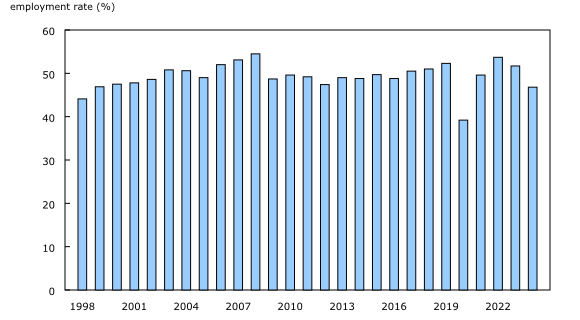
Unemployment rate rises to 6.4%
The overall unemployment rate rose 0.2 percentage points to 6.4% in June. It has trended up since April 2023, rising 1.3 percentage points over the period. There were 1.4 million unemployed people in June 2024, an increase of 42,000 (+3.1%) from the previous month.
Of those who were unemployed in May, just over one-fifth (21.4%) had transitioned to employment in June (not seasonally adjusted). This was lower than the pre-pandemic average for the same months in 2017, 2018, and 2019 (26.7%). A lower proportion of unemployed people transitioning into employment may indicate that people are facing greater difficulties finding work in the current labour market.
As the unemployment rate has increased over the past year, so too has the proportion of long-term unemployed. Among the unemployed, 17.6% had been continuously unemployed for 27 weeks or more in June 2024, up 4.0 percentage points from a year earlier.
Older unemployed persons were more likely to be in long-term unemployment; 22.0% of unemployed people aged 55 and older had been continuously unemployed for 27 weeks or more in June. In comparison, the proportion was 19.3% for those in the core-aged group and 12.2% for youth.
Chart 3
Unemployment rate rises to 6.4% in June
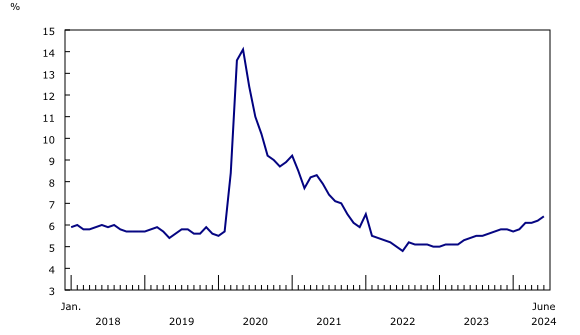
Youth unemployment rate increases in June
The overall unemployment rate for youth (aged 15 to 24) rose 0.9 percentage points to 13.5% in June. This was the highest rate since September 2014, outside of 2020 and 2021 during the pandemic. On a year-over-year basis, the youth unemployment rate was up 2.1 percentage points in June 2024.
The unemployment rate for core-aged men rose 0.2 percentage points to 5.6% in June. The rate for this group has trended up from a recent low of 4.0% in October 2022. Among core-aged women, the unemployment rate was unchanged at 5.1% in June 2024, and was up from a recent low of 4.1% in January 2023.
For people aged 55 and older, the unemployment rate was little changed at 4.9% in June 2024. On a year-over-year basis, it was up by 0.7 percentage points to 5.1% for men in this age group, while it was little changed at 4.8% for women.
Infographic 2
Unemployment rate trending up across all major age groups
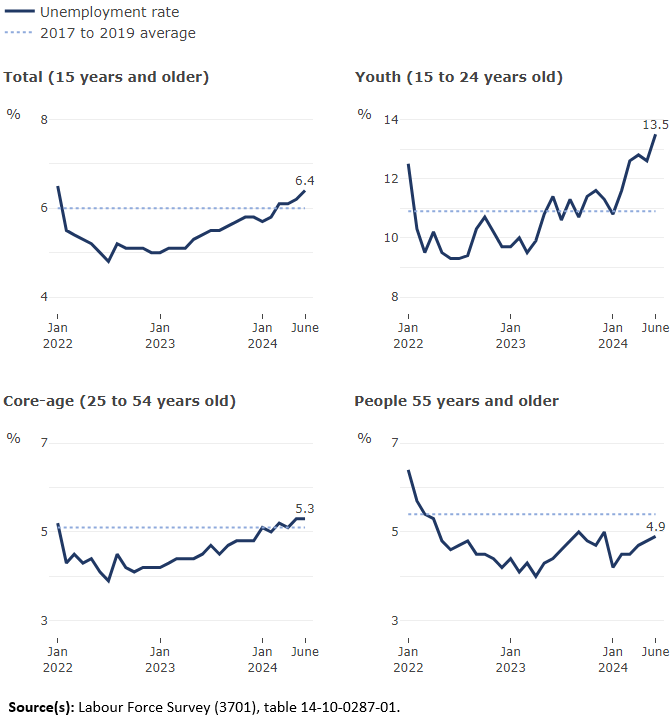
Unemployment rates rise for Black and South Asian Canadians
In the 12 months to June, the unemployment rate rose by 4.4 percentage points to 11.9% for core-aged Black Canadians (three-month moving averages, not seasonally adjusted). The rate was up by 5.7 percentage points to 12.3% for Black men and by 3.0 percentage points to 11.4% for Black women.
Among South Asians in the core-aged group, the unemployment rate was up 1.7 percentage points on a year-over-year basis to 6.7% in June. For core-aged South Asian women, the unemployment rate was 7.8% (+1.8 percentage points from a year earlier), while it was 5.9% for core-aged South Asian men (+1.7 percentage points from a year earlier).
For core-aged Chinese Canadians, the unemployment rate was 6.3% in June, and was little changed compared with 12 months earlier.
In comparison, the unemployment rate rose by 0.3 percentage points to 3.8% in the 12 months to June among the non-racialized, non-Indigenous population of core working age.
Wages increase on a year-over-year basis in June
On a year-over-year basis, average hourly wages for employees were up by 5.4% (+$1.79 to $34.91) in June, following growth of 5.1% in May. Average hourly wages were up by 5.2% (+$1.62 to $32.57) among women in June and by 5.5% (+$1.92 to $37.13) among men.
Wage growth remained relatively widespread across the wage distribution. On a year-over-year basis, the average hourly wage for employees in the bottom 25% of the wage distribution was up by 4.2% (to $17.74 per hour) in June, while for those in the top 25% of the wage distribution, it was up by 6.9% to $61.27 per hour.
In general, year-over-year growth in average hourly wages can reflect a range of factors, including changes in wages, composition of employment, and base-year effects.
Employment falls in transportation and warehousing for the second consecutive month
Employment in transportation and warehousing fell by 12,000 (-1.1%) in June, following a decline of 21,000 (-1.9%) in May. Employment in this industry was little changed on a year-over-year basis.
In public administration, employment declined by 8,800 (-0.7%) in June, the first decline since August 2023. On a year-over-year basis, employment in public administration was up by 24,000 (+2.0%).
Employment increased by 17,000 (+1.5%) in accommodation and food services in June, marking the third consecutive monthly increase, and bringing cumulative increases to 54,000 (+4.9%) since March.
In agriculture, employment rose by 12,000 (+5.5%) in June, the first increase since July 2023. Despite this increase, employment in agriculture was down by 18,000 (-7.2%) on a year-over-year basis in June 2024.
Chart 4
Employment falls in transportation and warehousing and public administration in June
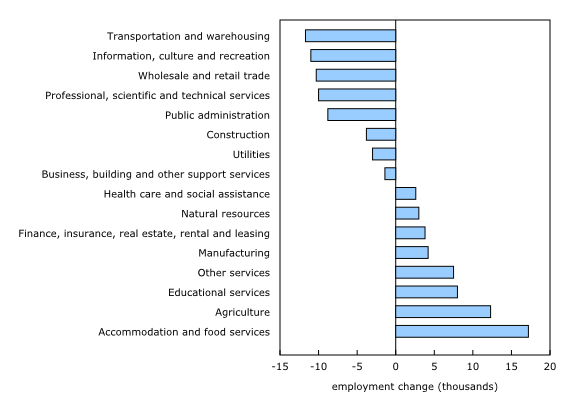
Employment declines in Quebec, while New Brunswick and Newfoundland and Labrador post increases
Employment in Quebec declined by 18,000 (-0.4%) in June, following little change in May. In the 12 months to June, employment in Quebec was little changed, and the employment rate fell 1.2 percentage points to 60.8%. In June, the unemployment rate in the province increased 0.6 percentage points to 5.7%.
In New Brunswick, employment rose by 3,000 (+0.8%) in June, the second increase in three months. The participation rate increased 0.3 percentage points in the month to 61.4%, leaving the unemployment rate little changed at 7.7%. Compared with 12 months earlier, employment in the province was up 4.2% (+16,000).
Employment also increased in Newfoundland and Labrador (+2,600; +1.1%) in June, lowering the unemployment rate to 9.2% (-0.7 percentage points). The employment increase in the month offset the decline in May and was the first monthly gain since January 2024.
While Ontario posted little change in employment in June, the unemployment rate increased 0.3 percentage points to 7.0%, as more Ontarians were searching for work. The unemployment rate in Ontario has increased 1.9 percentage points from its recent low of 5.1% in April 2023.
Map 1
Unemployment rate by province and territory, June 2024
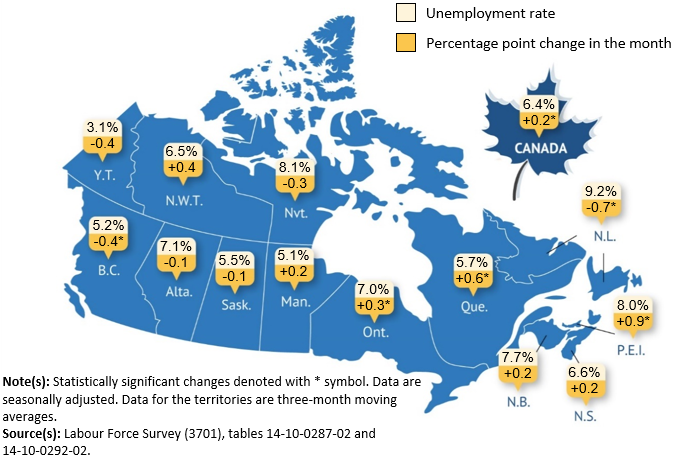
In the Spotlight: Teleworkers with a remote work location make up a growing share of employees usually working at home
The pandemic led to a notable shift towards working from home and hybrid work arrangements. Though the proportion of Canadians working from home has trended downwards following the lifting of most pandemic-related public health restrictions in 2022, some of the labour market trends associated with telework remain.
Among employees who usually work most of their hours from home, some report to a work location in the same city or nearby, while others report to a more remote work location, which may be situated beyond a commutable distance.
In June 2024, the proportion of employees who usually worked most of their hours from home was 15.1%, down from 21.5% in June 2022. This decrease was driven by a decline in the proportion of employees who usually worked mostly from home and whose office or work site was in the same city or nearby, down 6.4 percentage points to 11.4% from June 2022 to June 2024.
Thus, teleworkers with a more remote work location made up a growing share of employees who usually worked mostly from home, with just under one-quarter (24.2%) doing so in June 2024, up from 17.2% in June 2022.











